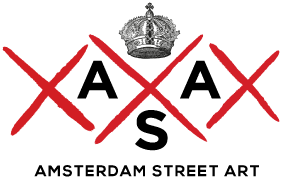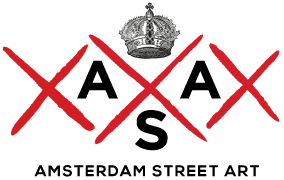After years of reveling in his (or her, or their…) anonymity while enjoying sensational media coverage and characterizations such as “elusive” “clandestine” and “mysterious,” the artist known as Banksy is finally getting a dose of legal-style reality.
Copyright is for LosersTM
Banksy famously included the text “Copyright is for LosersTM“ on the copyright page of his 2005 book “Wall and Peace,” and may soon regret his choice of words. The artist – now 14 years older and wiser – is currently embroiled in a series of lawsuits involving copyrights, trademarks, and various images associated with his brand. The precedents underlying these legal actions are quite interesting, and the length and complexity of their resolutions are firmly rooted in the artist’s obsessive desire to keep his/her/their true identity a secret.

Banksy is notorious for holding virtually no public art exhibits of his own, nor offering his work for sale directly to consumers. When enthusiastic fans of the artist contact Pest Control, Banksy’s self-proclaimed “handling service,” for information on upcoming releases or shows, often their inquiries are ignored, or are answered in a needlessly cryptic, sarcastic and/or condescending way. At the same time, Banksy openly grumbles about the booming secondary market for his work, where his pieces are exhibited and sold for enormous amounts of money – prices much higher than the artist’s original sale price – or so we’re told.
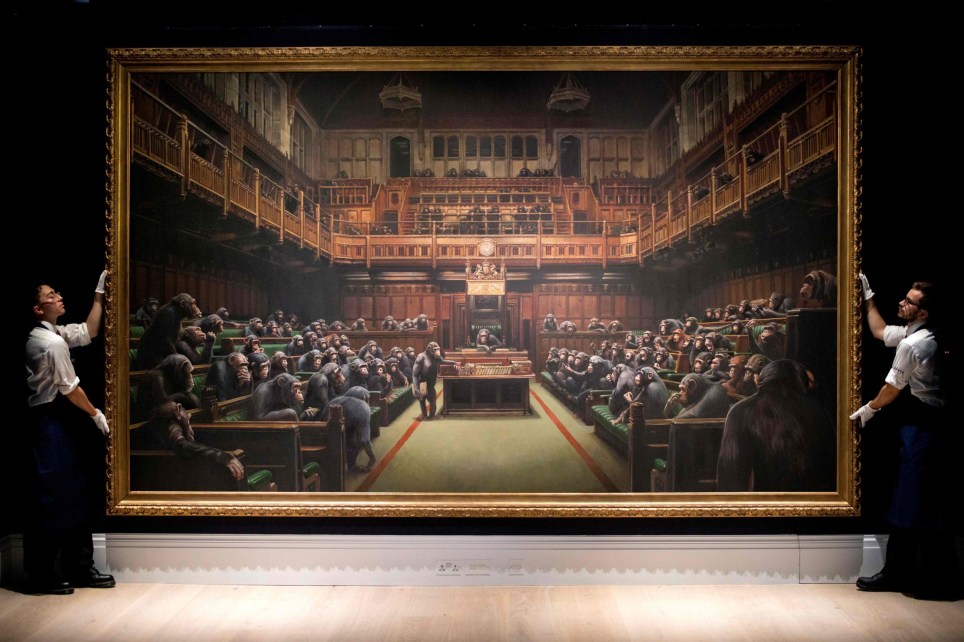
Work recently sold for 11,1 million Euro
Unauthorized
Since Banksy started his career as a street artist and still occasionally practices that craft today, maybe we can empathize a bit when he lashes out about collectors and galleries making far more money selling his street and studio pieces than he made upon their original sale. But while Banksy refers to these shows and sales as “unauthorized,” he can’t be serious. He’s familiar enough with the rules of the open and free art market to know better. The simple fact is that his authorization is not required for exhibiting and selling artworks legally owned by others.
We might also understand some of the artist’s complaints about the many knockoffs, rip-offs, and forgeries for his works flooding the market if Banksy had made any proactive attempt to engage in commerce with the interested public. Instead, his continued lack of interest in making his works more widely available, coupled with his incessant whining about this troublesome aspect of being a wildly-successful artist, shows that the artist is still tone-deaf to the realities of commerce and public relations.
The art-curious public does not understand these complaints, partially because of the assumption that Banksy has plenty of money. His complaints ring hollow for those of us who cannot afford a single small piece of his work, or find a decent Banksy exhibition, authorized or not, to attend. He’s like a wealthy vacationer complaining about the temperature of the sauna at a luxury resort.


Examples of types of items Banksy fans buy because they appreciate the artist’s work. Unfortunately, fans are forced to buy unauthorized items because the artist himself has refused to produce anything available or affordable enough for regular fans.
Banksy is also a notorious prankster. In fact, when many in the art industry hear “news” about Banksy, our first reaction is skepticism. Even seemingly normal communications such as press releases and announcements often require decoding and discussion, sometimes at length, to be fully understood. Certainly nothing that emits from the Banksy Camp is to be taken at face value. Witness the way that Banksy himself has tried to spin the current legal proceedings. Through carefully worded statements about the matter, the artist, whose net worth is estimated at over $50 million dollars, has tried to paint himself as the victim.
Banksy’s entire career has been characterized by anonymity, ironclad control over his image and identity, skillful manipulation of the media, authorities and institutions, and the timely exploitation of current events as artistic subject matter. For all of these reasons and more, most fans wouldn’t have believed any scenario where Banksy was portrayed as the victim or as having been taken advantage of. Upon further inspection of the facts, I believe most won’t believe it now.
What happened?
Recently, the artist was dragged into a more normal role as Englishman-in-court (vs. that of International Art Rock Star, or whatever) when a London-based greeting cards company filed a motion contesting Banksy’s trademarks, citing the artists’ failure to adequately defend them as required by law. This is the ultimate challenge to Banksy – it’s the Kryptonite to his Superman act – at least in a court of law. The proceedings could potentially force him to choose between revealing his true identity or losing ownership of certain important elements of the Banksy brand.
The manner in which Banksy’s legal team defended a recent, separate, Italian trademark challenge is due almost completely to the artist’s insistence on remaining anonymous. It has to do with the subtle legal differences between copyright and trademark law, which at least partially explain why Banksy and his legal team are choosing to focus on the latter rather than the former.
This legal strategy was noted in a recent Fast Company article, just as the Italian case was unfolding:
“What is also noteworthy in this case is that Pest Control has decided not to enforce Banksy’s copyright. Such a decision doesn’t come as a surprise though, as it would require Pest Control to show judges that it has acquired the copyright from the artist. But this would entail the disclosure of Banksy’s real name, which the artist obviously doesn’t want to reveal as it would remove the aura of mystery surrounding him, and consequently reduce the value of his art.”
If you have any further questions about the legitimacy of Banksy’s current legal troubles or you’re surprised that such a case would even proceed given the artist’s stature and fame, please read this article prior to proceeding. I think it will help you understand that Banksy and his attorneys are in a very tight spot, indeed – and for good reason.
In what critics and pundits are calling a “pathetic” and, alternately, a “brilliant” attempt to make up for lost trademark time, the artist recently leased a space in Croydon, south London and filled it with an assortment of Banksy-branded goods. A document behind the store’s window explained the reason for the shop: in order to properly secure the artist’s copyright and trademarks (and to stave off current and future legal challenges thereto) Banksy’s lawyers have finally advised the artist to sell his own range of branded merchandise.

Gross Domestic ProductTM (GDP) storefront in London, picture by Tim Jentsch.
From this point, the peculiarities pile up faster than we can cover in this article, but suffice it to say that Banksy appears to be going through the minimum legally-required motions to protect his property, marks, and rights. These motions apparently include setting up both a physical store and a website, through which the artist is marketing what appears to be a hastily-assembled (and grossly understocked) range of branded items.
Unfortunately, both of the physical pseudo-store and the website clearly demonstrate the artist’s lack of enthusiasm for the process or projects, and instead highlight his newfound legal religion. Whoever Banksy is, they seem to have approached the direct-sales project with all the enthusiasm of a child forced to eat broccoli at the dinner table. And if he’s forced to eat broccoli, he’s going to make sure everyone at the table shares in his misery.
Gross Domestic ProductTM (GDP)
The bricks-and-mortar Gross Domestic ProductTM (GDP) storefront in London existed for only two weeks, and never actually opened its doors to buyers. It was merely a marketing stunt designed to raise awareness of, and increase demand for, the unique assortment of items soon to be released via the GDP website. The Croydon store may have also ticked some type of legal box regarding a physical storefront along the way. The GDP website launched the same day that the physical store closed, and the website stopped accepting online “registrations” according to plan, also after only two weeks – on October 28, 2019.

Gross Domestic ProductTM (GDP) storefront in London, picture by Tim Jentsch.
As expected, hundreds of thousands of Banksy fans flooded the GDP website the moment it went live. Most had hopes of finally purchasing a piece of artwork through a process devoid of the uncertainty and ambiguity they’d find in the secondary market. Many site visitors were confused and irritated by what they found. The site’s subtitle of “Where Art Irritates Life” couldn’t be more appropriate. What Banksy and his entourage apparently lack in basic awareness, legal prowess, and business savvy, they more than makeup for in sarcasm and tired hyperbole.
Instead of quickly purchasing a piece of art, site visitors found themselves agreeing to eight pages of highly restrictive Terms and Conditions. After signing many of their ownership rights away via these Terms and Conditions, registrants were then afforded the distinct privilege of “registering” to possibly, maybe, (if they’re lucky and well-behaved) qualify to purchase a single item of their choosing, sometime in the ill-defined future. Or maybe not. Actually, let’s make that probably not.
The eight pages of GDP Terms and Conditions are highly detailed and, in the eyes of many, unrealistically restrictive. As with most license/purchase agreements, such as with software downloads and other online purchases, most people will simply not read them. While perhaps designed with other goals in mind, the net effect of the terms will be to make it extra difficult for normal fans to acquire a piece of the artist’s work. The contract also reduces the award process to almost pure luck, and describes a system based on random time samples, a brief narrative judged by a comedian, and an excruciatingly low number of awards distributed over an extended period of time.
Prior to collecting any visitor registration data, the GDP site clearly states that the online art shop is “not first-come, first-served,” that entrants are limited to a single item “due to the limited number of products currently available,” and that registrants will be chosen at random to receive a payment/checkout link within seven business days of close-of-registration. That means that all approved applicants should be notified of their option to purchase by end of business U.K. time on Monday, 4th November. Today.
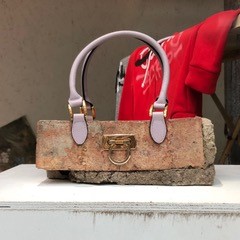

Gross Domestic ProductTM (GDP) storefront in London, picture by Tim Jentsch.
The site text goes on to explain that the initial offerings are available at prices far below market value and kindly requests that “wealthy art collectors” refrain from registering at this time. Then, in an apparent attempt to manage expectations, Banksy (or whoever scripted the site) reminds all registrants that inventory is limited, as is expected future production, and that “…GDP may prove to be a disappointing retail experience – especially if you’re successful in making a purchase…” A key section follows this statement wherein Banksy underscores their ability to cancel the transaction even after accepting payment, if you’ve breached the agreement, or if Banksy’s lawyers “reasonably believe” that you might.
The Terms and Conditions
On to the Terms and Conditions! But wait…
Unfortunately, I can’t reference them in any meaningful way without first (you guessed it!) obtaining a license from Banksy. I’m also prohibited from even linking to the Terms and Conditions so that you can quickly visit them yourself. Instead, Banksy has graciously allowed us to link to the homepage of his bare-bones website. So here, I guess. Please go find and read them yourselves. In the exceedingly unlikely event that you or someone you know might be selected as a Banksy Lotto Winner… uh… Customer, you will want to know all the stuff that you can’t do, and how to properly do the few things that you, however begrudgingly, are allowed to do.


Gross Domestic ProductTM (GDP) storefront in London, picture by Tim Jentsch.
I would direct interested parties to sections of the Terms and Conditions that cover the following areas in particular: Contract for Sale, Delivery Timeframe After Purchase, Resale Prohibited Prior to Receipt, Other Terms, and Certificates of Authenticity. These sections cover most of the laughable aspects of Banksy’s desperate and awkward attempt to strangle the life out of that pesky secondary market. Indeed, it’s this obsessive struggle against the art market, rather than his amazing artwork, that may yet define Banksy’s legacy.
For fear of swift and terrible legal retribution by the formerly illegal artist known (for now) as Banksy, I will not elaborate on these points any further.
Banksy seems to have gone from “asleep at the intellectual property wheel” to “legal overcompensator in chief” in the space of about a year. And if, as is widely reported through current media, Banksy & Co. received interest from 200+ countries, GDP registrants probably number in the hundreds of thousands, or even millions. It is clear to me that 99% or more of registrants will never actually own any merchandise from the current sale, or “gamed raffle,” or whatever this GDP event should be rightly called.
It is sad that it has come to this.
While Banksy wants to blame everyone else for his current situation – galleries, museums, collectors, card companies, exhibit coordinators, former employees – the list goes on and on – he has no one to blame but himself.
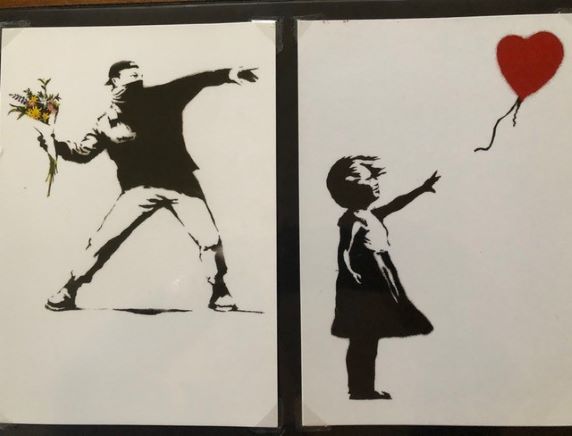
Examples of types of items Banksy fans buy because they appreciate the artist’s work. Unfortunately, fans are forced to buy unauthorized items because the artist himself has refused to produce anything available or affordable enough for regular fans.
Many of Banksy’s street art pieces are modern masterpieces. The combination of the artist’s considerable talent, excellent placement, insightful and/or poignant messages, and the inventive and surprising ways that the works are created, deployed and unveiled, adds up to a hugely satisfying experience for all – even the artist, I am sure.
On the other hand, items sold through Gross Domestic Product may not even made by Banksy himself. According to the website, They’re “produced by a handful of people using recycled material wherever possible in a workplace culture of daytime drinking.” Reading between the lines, it appears to me that Banksy is setting up a factory of sorts, perhaps in the style of his other nightmarish creation, poseur artist “Mr. Brainwash,” where Banksy himself may have little or nothing to do with the actual artwork other than setting ever-escalating prices.
Being Unknown
Banksy is also hugely famous for simply being unknown. If we knew with certainty that the artist was actually Robert “3D” del Naja, Jamie Hewlett or Robin Gunningham – or a pensioner librarian living in a garden cottage, for that matter, I’m not sure what would change. Not much from my perspective. Banksy however, clearly lives in mortal terror of his/her/their true identity being revealed, apparently convinced that it would vastly undermine the value of the “Banksy brand.” I can’t imagine what a miserable existence that must be, especially over time.
I wish that Banksy could have stuck to street work.
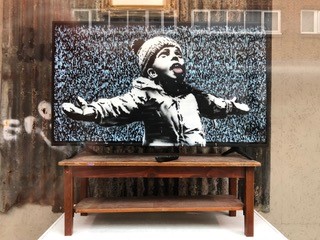
Gross Domestic ProductTM (GDP) storefront in London, picture by Tim Jentsch.
It would have spared us all the ugly reality of our once-cavalier street art hero (Copyright is for losers, dammit!!) reduced to relying on stiff-backed corporate legal nerds to save the edgy art empire that he’s jeopardized through inattention and aloofness.
It would have spared us having to listen, cringing, as Banksy launches into yet another tone-deaf tirade over someone exhibiting the art, HIS art, that we’re all interested in seeing – and whether or not he “authorized” the exhibit.
We’re all street art fans here; otherwise, we wouldn’t even be reading this article. We can also appreciate the need for anonymity when practicing that craft in the streets, particularly when the work is unauthorized or straight-up illegal. What’s hard for us to understand is what Banksy expected to happen here, and how he failed to take basic steps to secure his rights over the THIRTY YEARS he’s been doing what he does.
While Banksy’s art began as it does for most artists – an exciting and passionate hobby – it quickly morphed into a business. And while I understand the anti-capitalist nature of his work and his “brand,” that doesn’t excuse the kind of inattention that he’s displayed, or his sour-grapes attitude about the incredible demand for his work. If he didn’t want his works to be resold for tons of cash, he should have sold them only to people who would agree (as he’s doing now with GDP) to ridiculously-restrictive terms regarding their resale.

Gross Domestic ProductTM(GDP) storefront in London, picture by Tim Jentsch.
Even as I write this, I can’t help but wonder if the whole GDP experiment is just another cheeky chapter in the self-serving Book of Banksy. In fact, I’m pretty sure it is, and that the joke will ultimately be on the “winners” in this silly charade.
For an artist who made his name through unauthorized work done in unauthorized places by unauthorized people, it’s really sad to see this once-firebrand artist condemning shows and sales of his work while offering no events or merchandise sales of his own, which he could have controlled and profited directly from.
That is, until he was literally forced to do it in order to save his own livelihood.
